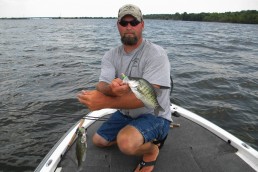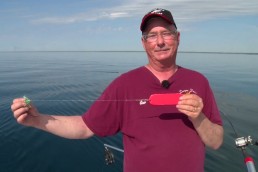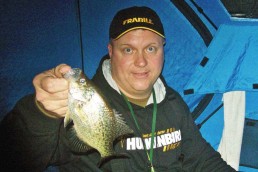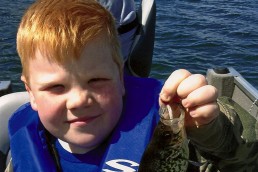Spring Crappie Action Puts Great Eating on the Table
SHARE THIS POST
There’s more to crappie fishing than simply eating the results. Seeing that float bobbing below the surface and then heading for the brush, and the finesse needed to hoist that hefty fish toward you, makes the search for this gamefish delightful. Taking someone new to the sport on an excursion in search of crappies is a great way to put a smile on their face, and more food on their dinner table.
Of the two species of crappies, the white prefer larger, more open water and with a bit more turbid in its clarity. But both species will suspend in relation to the points, sunken islands, bars, creek beds and debris found in rivers and impoundments. Both can inhabit the same waters, although most of the time one is found more than the other based on water conditions and available forage.
Both species have roughly the same spawning habits, sweeping out nests and laying eggs in water 3 to 8 feet once temperatures near the 60s. Whites tend to like spawning around brush piles, flooded bushes or sunken logs; the blacks tend to prefer reeds or other weeds. There is pre-spawn angling in the channels and bays just after ice-out with the water still too cold for their spawn.
April is a transitional month for crappie anglers, and Upper Midwest waters still are fishing on ice in some areas while those farther to the south are seeking pre-spawn fish in open water. The difference in temperatures in spring tends to vary the spawning time. Additionally, some areas such as power plant lakes will have the spawn take place before it does on any nearby natural lakes. In all cases, pre-spawn fish will show up in deeper water as they stage prior to mating.
In reservoirs, deep creek beds are often the key to coldwater crappie locations. Begin by searching for likely summer-holding areas in the main lake and then backtrack to the nearest deep creek bed where it enters the main body of the reservoir. Then follow the creek channel back into the cove to the best available holding area near shallower spawning flats.
Some creek beds are more promising than others. Those with flooded wood cover in or near the creek channel are usually best while standing timber and sunken brush or trees are excellent locations as well. Stumps will do the trick too with the densest wood offering the best holding areas. If the rivers or creeks do not seem to have any wood cover, try channel bends and intersection areas. Sharp channel bends or intersections with roadbeds or secondary channels often produce fish. Shallow areas with dark bottoms on the northern sides of coves are often good sources as they get the best early-sun exposure and hold warmth longer.
Are you enjoying this post?
You can be among the first to get the latest info on where to go, what to use and how to use it!
Channels that dead-end minimize current flow that draws off warm water. Good bays generally have no channels, or at least not adequate ones, so they serve the same purpose. If all else fails, try the adjacent deeper waters on any available structure.
Jigs are the bread and butter of crappie lures. A good assortment of lead-head jigs from 1/16 to 1/64 ounce in “crappie colors” like white, black and yellow are good choices; couple them with tube bodies of the same colors. For natural baits, the basic choices are minnows or waxworms.
Suspending jigs below slip floats baited with minnows can produce a lot of fish. Crappies are very spooky at this time of year, and if scared, they will stop feeding. The best approach is to locate the fish then make long casts to a school. Make short pauses in the retrieve of about 30 seconds each, and then move the bobber a few feet and pause again.
Crappie strikes usually occur as the jig begins to settle to the bottom of the length of line below the float. Small, sensitive floats help reveal very light bites. The float may not move, but if the line makes an unusual movement or the float turns over, set the hook.
Spring-crappie fishing isn’t difficult, but it does require a bit of searching to locate schools of active fish. Once you find them, simple tactics usually entice results, putting crappies on the line and on the menu.
MWO
SHARE THIS POST
Did you enjoy this post?
You can be among the first to get the latest info on where to go, what to use and how to use it!
Don Gasaway
Don Gasaway is a veteran freelance outdoor writer from Marion, Ill. He may also be found at: https://www.facebook.com/DonGasawayWriter and facebook.com/Wandering Angler. Comments are welcome



